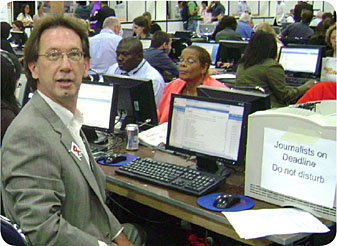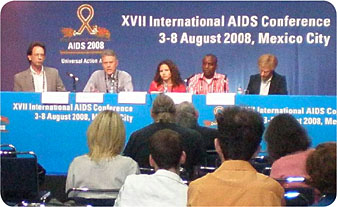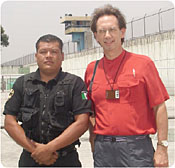 |
|
Mexico City: A Prison and a Press Conference THE PROBLEM: Although PSI had always gotten some media coverage for its hard-hitting, innovative and market-based programs , it was usually the result of a journalist stumbling across PSI rather than anything we did to attract attention. In 2007, several stories in major media questioned the role of social marketing, particular with regard to the delivery of insecticide-treated nets to prevent malaria. One article by Donald McNeil Jr. in the New York Times was particularly uninformed: He wrote a poorly researched story about the social marketing of mosquito nets without even contacting PSI, the world leader in the social marketing of nets. I decided it was time to take a more proactive approach to media relations. THE SOLUTION: I hired Burness Communications of Bethesda, Maryland to help us generate some favorable media coverage at the Mexico City International AIDS Conference in August 2008. John Donnelly, one of my best media contacts when he reported from Africa for the Boston Globe for several years, had recently joined their staff and I liked and trusted him. There was one big advantage for us in the location of the conference - PSI had a program in Mexico and therefore potentially something we could show journalists. The final choice was easy: PSI had an HIV prevention peer education program in several Mexican prisons, including the largest prison in the country in Mexico City. We decided to take a small group of journalists inside. THE RESULTS: It worked. It was risky, and the article at right explains why. But we got major media coverage from all of the journalists in the group, including The New York Times, The Financial Times, the BBC, Le Monde, and CNN en Espanol. The other major opportunity at the conference was a press conference we staged in the Media Centre on the first day of the conference. Despite the fact that PSI had been at most AIDS conferences since the early 1990s, this was the first time we had staged our own press conference. The only problem was that we originally did not think we had any news: We wanted to talk about the need for male circumcision in eastern and southern Africa but we had no important news peg on which to hang this idea. However, Burness was able to talk the conference leadership into allowing one of the scientists who was on our panel to release his study early during the briefing, which gave us the news hook we needed. And even though former President Bill Clinton chose exactly the same time to give his only speech at the conference in the room next door, our event attracted over 20 journalists and we got press coverage exceeding our expectations. Economist reported that "Amid the gloom about microbicides and vaccines, circumcision is the one bright spot in the field of AIDS prevention" as a direct result of its correspondent's presence at our press conference: The Economist, The New York Times, and all the major wire services filed stories mentioning male circumcision. There was coverage in at least eight languages and we believe that our press conference moved male circumcision to a different level of public awareness. Only four months after this press conference, PSI signed a $50 million contact with the Bill & Melinda Gates Foundation to scale up male circumcision in southern Africa starting in Zambia and Swaziland. The combined coverage from the prison visit and the male circumcision press conference produced the greatest media coup in PSI's 40-year history.  David at the media center of the Mexico City International AIDS Conference. |
|
 David (left) moderating a press conference on male circumcision in Mexico City. "David is both creative and even-tempered, a terrific combination in a public relations professional. He hired our firm to help him draw attention to PSI's worldwide efforts to prevent HIV. During the recent AIDS conference in Mexico, he had great ideas for stories he thought reporters would find interesting, and for identifying just the right colleague to tell a particular story. Best of all, my colleagues and I found that David created an environment that made it easy for all of us to succeed. He congratulated the team when we did well, and encouraged us to persevere when we hit a rough spot. I'd work with him again any time." November 19, 2008 - Coimbra Sirica, Vice President, Global Health and Science , Burness Communications  David with prison guard. How to Break Into Prison with Reporters (Originally published in PSImpact, PSI's internal newsletter) MEXICO City, Mexico - There was always a certain element of risk in taking a group of international journalists into the middle of Reclusorio Preventivo Oriente, Latin America's biggest prison, to view PSIs ground-breaking HIV prevention peer education program the week of the international AIDS conference held here in August. I am not talking about the risk of bodily harm even though we had to inform journalists that they were entering a highly volatile environment (they were told to bring no watches or jewelry, and to wear clothing that would stand out in case of "an incident"; note my red shirt above). No, the risk that worried me was that either the journalists would not be interested in spending the better part of a day away from the conference visiting a program with no news value. Or worse, that they would be interested but that skittish prison officials would deny us entrance at the last minute. We were informed early on by former PSI/Mexico CR Olivier LeTouze that this was a distinct possibility. At first, we did not think we had enough news value to lure journalists away from the conference. Although PSI/Mexico's program is three years old, there is no solid evidence of health impact. We asked whether the journalists could meet with former prisoners, in hopes that the HIV prevention strategies they had acquired in prison had served them well outside. But we were told that when men leave the prison, there is a ritualistic burning of prison clothing and belongings and cutting of all prison ties. Ricardo Roman of PSI/Mexico told us that interviewing former inmates would not only be difficult but dangerous. The prison officials were concerned that the journalists would report on poor conditions at the prison. We told them that the journalists were in Mexico City to cover an AIDS conference and were only interested in the prison HIV prevention program, which would reflect well on the prison. We also worried when prison officials demanded to review and approve the reporters stories before they were published or aired. We knew that the caliber of journalists we planned to attract would not accept that. We ignored the request, and hoped it would not prove a deal-breaker. In the end, all obstacles were overcome. The story was reframed: It would not be a health impact piece but an article on the difficulty of doing HIV prevention work under very challenging conditions. It would be a story showing how a small group of dedicated PSI/ Mexico staff and their prisoner-peer educators were making a difference in reaching a group that is at high risk of infection in five prisons with only $1 million a year. In the end, the visit to the prison became a hot ticket: Coimbra Sirica of Burness Communications, who orchestrated the visit, told me that other PR people organizing similar visits were avoiding our time slot as they knew they could not compete with us. Our line-up a few days before the visit on Aug. 6 included The New York Times, Washington Post, Financial Times, Le Monde, BBC and CNN en Espanol (the Post dropped out just before the visit). I believe we could have added more but we were limited, or so we were told at the time by prison officials, to no more than 10 people (including PSI staff). And the prison officials, though initially nervous about bringing in journalists of any type, invited a number of Mexican newspaper reporters on their own initiative. Apparently, the officials had decided that opening up their prison to the world to show this program would, in fact, reflect well on them. The visit went off without a hitch and all the reporters filed stories that gave PSI its greatest spate of media coverage ever. - David J. Olson |
